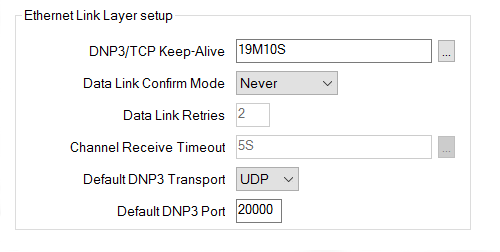Setup the Ethernet Link Layer
Use the fields in the Ethernet Link Layer setup section of the DNP3 Settings tab to specify the default DNP3 over IP properties for the SCADAPack x70 device.

Use this setting when the SCADAPack x70 device connects to remote intelligent electronic devices (IEDs) or Remote Terminal Units (RTUs) through DNP3 TCP/IP.
This setting allows you to specify how often a DNP3 Link Status test message is transmitted across the active TCP socket. The timer can help to recover from communication stoppages, and to help ensure that the link remains active.
Sockets may be closed by the network infrastructure if no data is transmitted for a certain period (The period will depend on the network infrastructure ).
If the timer is not required, set the value to zero.
Enter the required interval in the OPC Time Format. You can enter the value directly in the field, or use the Interval window (accessed via the field's browse button) to specify the required value.
The DNP3 Link Status only uses the TCP link to send status requests, UDP links are not used.
When setting this timer, keep in mind that the shorter the timer, the higher the number of DNP3 link status messages. Higher numbers of messages can potentially affect communications costs.
The timer restarts each time DNP3 traffic passes through the TCP socket. As a result, this timer is typically set to be longer than the standard poll rate.
Use the combo box to specify when the SCADAPack x70 device requests confirmation of transmission of data link layer frames to a DNP3 node. If a confirmation message is requested, the SCADAPack x70 device waits until the confirmation is received before sending the next DNP3 frame.
The following options are available:
The outstation does not request confirmation. As defined by the DNP3 standard, select this option if the outstation is connected from end-to-end on a TCP/IP network (as TCP/IP provides its own flow control measures).This is also the recommended option for outstations with other communications setups, unless the communications link between the outstation and the DNP3 node is poor.
If a message is split into more than one frame, the outstation requests a Data Link confirmation for each frame. If the fragment fits within one frame, the outstation does not request a Data Link confirmation.
This setting is commonly used when the communications network is non-ideal—for example, if the devices are operating in high interference environments.
The outstation requests a confirmation for each frame that it sends. This option is rarely used, as it results in the outstation sending both an ACK and a response for every message that it receives from its SCADA master. If the ACK gets lost or corrupted, the SCADA master will attempt to resend the message, however the original outstation response may still reach the SCADA master. Should this occur, it will result in the SCADA master performing unnecessary Data Link retries.
You might consider using this option if the outstation is on a serial or radio network that suffers from a lot of interference, to attempt to control the flow on that network. However, we strongly recommend that you fully test such a transmission setup in case the resulting increase in communications traffic does not have the desired effect.
Data Link Retries and Channel Receive Timeout apply only if the Function of the port is set to DNP3 or PPP/TCPIP, and the Data Link Confirm Mode is set to an option other than Never.
Specify the number of times that the outstation will resend any ethernet link layer frames for which it has requested a confirm, but for which it does not receive the confirm response within the Data Link Confirm Timeout.
Specify how long the outstation is to wait before re-sending any data link layer frames for which it has requested, but not received, a confirm response. The frames will be re-sent at this frequency, up to the number of times specified by the Data Link Retries field (see above).
Enter the required interval in the OPC Time Format. You can enter the value directly in the field, or use the Interval window (accessed via the field's browse button) to specify the required value.
When the SCADAPack x70 device sends DNP3 Master requests, such as polls, this parameter is also used as the time to wait for the next expected receive frame on the port.
Use the combo box to specify the default transport protocol that is to be used to transmit outbound (initiating) DNP3 frames across LAN/WAN links. Response frames use the same protocol as the initiating frames. Choose from:
- TCP—Use Transmission Control Protocol (TCP), a connection-orientated transport protocol
- UDP—Use User Datagram Protocol (UDP), a connection-less transport protocol.
Specify the TCP/UDP port number to which DNP3 frames are sent and from which they are received. The valid range is from 0 to 65535. The default is 20000, which is the IETF assigned port number used by the DNP3 protocol.